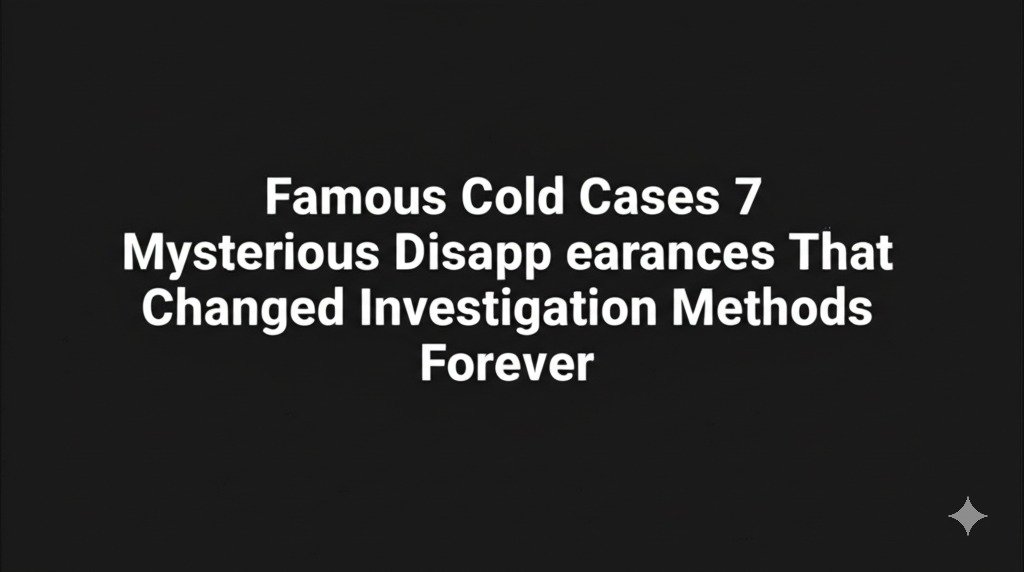What happens when a trail goes cold, and justice seems out of reach? The most perplexing disappearances in history have not only left investigators baffled but revolutionized the way we solve crimes today. From groundbreaking DNA analysis to innovative digital forensics, these 7 mysterious cold cases transformed modern criminal investigation methods forever. Each disappearance challenged conventional techniques, forcing investigators to pioneer new approaches that would later become standard practice. These haunting cases include: • The first use of genetic genealogy in solving decades-old mysteries • Revolutionary surveillance analysis techniques • Groundbreaking digital reconstruction methods • Game-changing forensic science applications Join us as we unravel these compelling disappearances that not only captured public attention but reshaped the future of criminal investigations. Whether you’re a true crime enthusiast or fascinated by investigative breakthroughs, these cases will show you how failure often leads to innovation.
Key Takeaways:
- – Each missing person case contributed unique investigative techniques, from advanced DNA analysis to digital reconstruction methods that are now standard practice.
- – The disappearances span various scenarios – from a young woman in New York City to mysterious vanishings in national parks – showcasing how different environments require specialized investigation approaches.
- – These cold cases led to the development of new techniques in surveillance analysis, helping law enforcement adapt to modern technological challenges.
- – The investigations highlighted the importance of preserving evidence and maintaining detailed case info, even when leads seem exhausted.
- – These cases demonstrate how traditional investigative methods combined with innovative forensic science can help solve decades-old mysteries, giving hope to similar unsolved cases.
Conclusion
These seven haunting disappearances have forever altered the landscape of criminal investigations, pushing the boundaries of conventional methods and fostering groundbreaking innovations. From Dorothy Arnold’s mysterious vanishing that revolutionized missing persons protocols to the Etan Patz case that transformed how we handle child disappearances, each story has contributed to the evolution of modern forensic science. The legacy of these cold cases extends far beyond their individual circumstances. They’ve inspired the development of advanced DNA analysis, digital reconstruction techniques, and sophisticated surveillance methods that continue to help solve contemporary crimes. These cases remind us that even when justice seems distant, every investigation contributes to our collective knowledge and capabilities in criminal science. For those fascinated by true crime and investigative breakthroughs, these cases serve as powerful examples of how failure often catalyzes innovation. By studying these mysterious disappearances, we not only honor the memories of those lost but also recognize the relentless pursuit of justice that drives investigative progress forward.
FAQs
How do modern investigation methods differ from those used in historical cold cases?
Modern investigations utilize advanced DNA analysis, digital forensics, and behavioral profiling, unlike historical methods that relied mainly on witness testimonies and physical evidence. Today’s techniques include genetic genealogy, advanced surveillance systems, and sophisticated database management for cold case investigations.
What percentage of cold cases are typically solved after implementing new investigation methods?
Statistics show that approximately 20-30% of cold cases are solved when revisited with modern investigative techniques. Success rates vary depending on factors like evidence preservation, witness availability, and the implementation of new technological advancements in forensic science.
Can social media help in solving cold cases?
Social media has become a powerful tool in solving cold cases by reaching wider audiences, gathering new leads, and connecting with potential witnesses. Many law enforcement agencies now use platforms like Facebook and Twitter to share case updates and generate public interest.
What role does DNA technology play in reopening cold cases?
DNA technology has revolutionized cold case investigations through advanced techniques like genetic genealogy and familial DNA matching. These methods can identify suspects by linking DNA evidence to family members in genealogical databases, even decades after the crime.
How long can evidence from cold cases be preserved?
With proper storage conditions, physical evidence can be preserved for decades. DNA evidence can remain viable for 20-30 years or more when stored correctly. Modern preservation techniques have significantly improved the longevity of various types of forensic evidence.
What impact do true crime documentaries have on cold case investigations?
True crime documentaries often generate renewed public interest in cold cases, leading to new tips and witnesses coming forward. They can also pressure law enforcement to reopen cases and allocate additional resources to unsolved investigations.

